MGT5OBR: Analyzing Conflict and Motivation Theories in Organizations
VerifiedAdded on 2022/08/25
|12
|2644
|17
Essay
AI Summary
This essay provides an in-depth analysis of two key organizational behaviour theories: conflict theory and motivation theory. It begins by introducing the inevitability of conflict within organizations, discussing various types such as interpersonal, role, and intergroup conflicts, and explores the advantages and disadvantages of organizational conflict. The essay then delves into motivation theory, examining its role in enhancing employee performance and achieving organizational goals, covering elements like needs, incentives, and drives. It explores expectancy and reinforcement theories, and the impact of perceptions, including equity theory and goal-setting theory. The relationship between the two theories is then examined, highlighting how motivation can prevent organizational conflicts and promote job satisfaction, leading to improved performance and smooth operations. The essay aims to evaluate these theories in the context of organizational behaviour to help people and organizations achieve high performance levels and ensure all organization members achieve satisfaction from their task contributions and work experience.
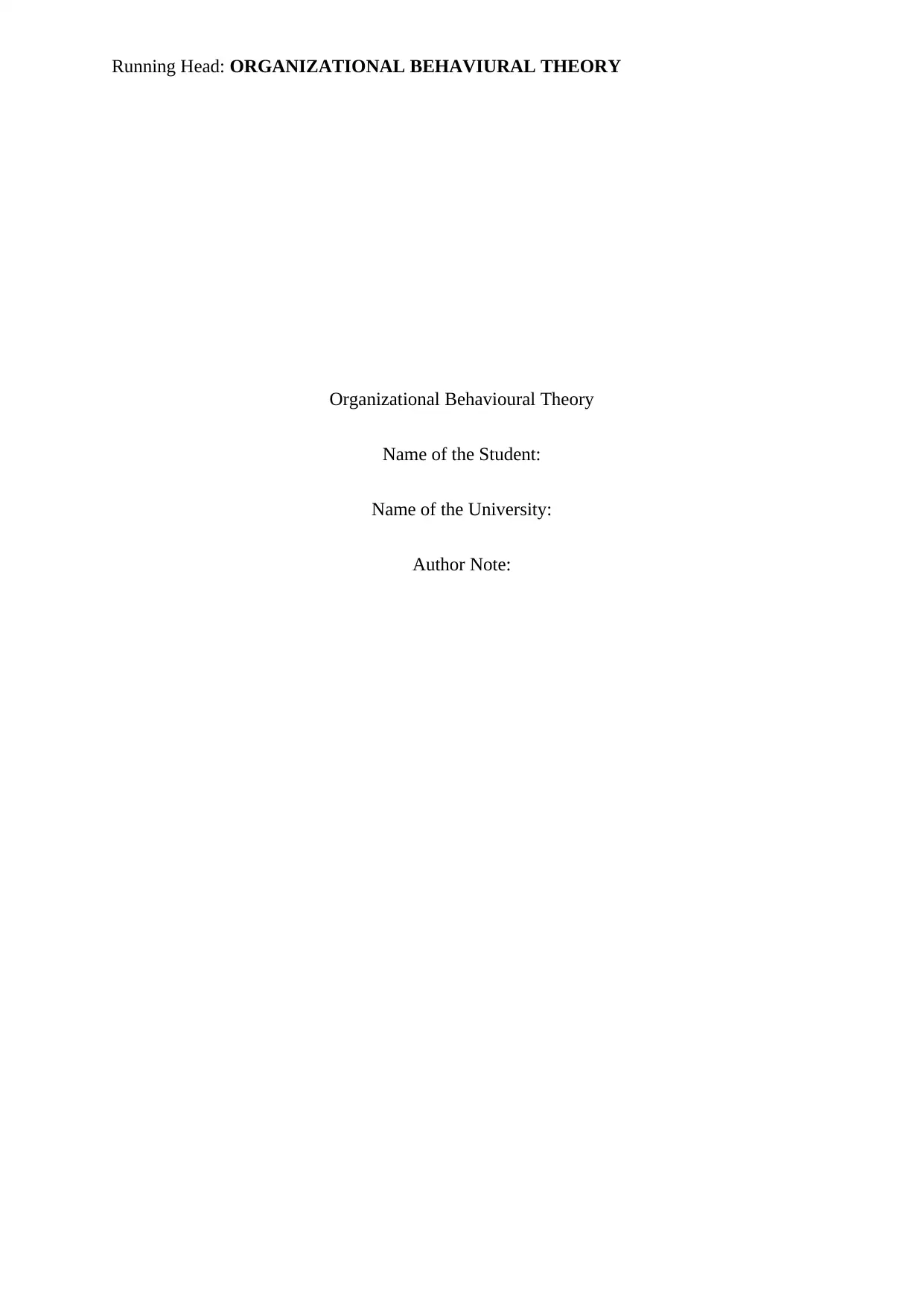
Running Head: ORGANIZATIONAL BEHAVIURAL THEORY
Organizational Behavioural Theory
Name of the Student:
Name of the University:
Author Note:
Organizational Behavioural Theory
Name of the Student:
Name of the University:
Author Note:
Paraphrase This Document
Need a fresh take? Get an instant paraphrase of this document with our AI Paraphraser
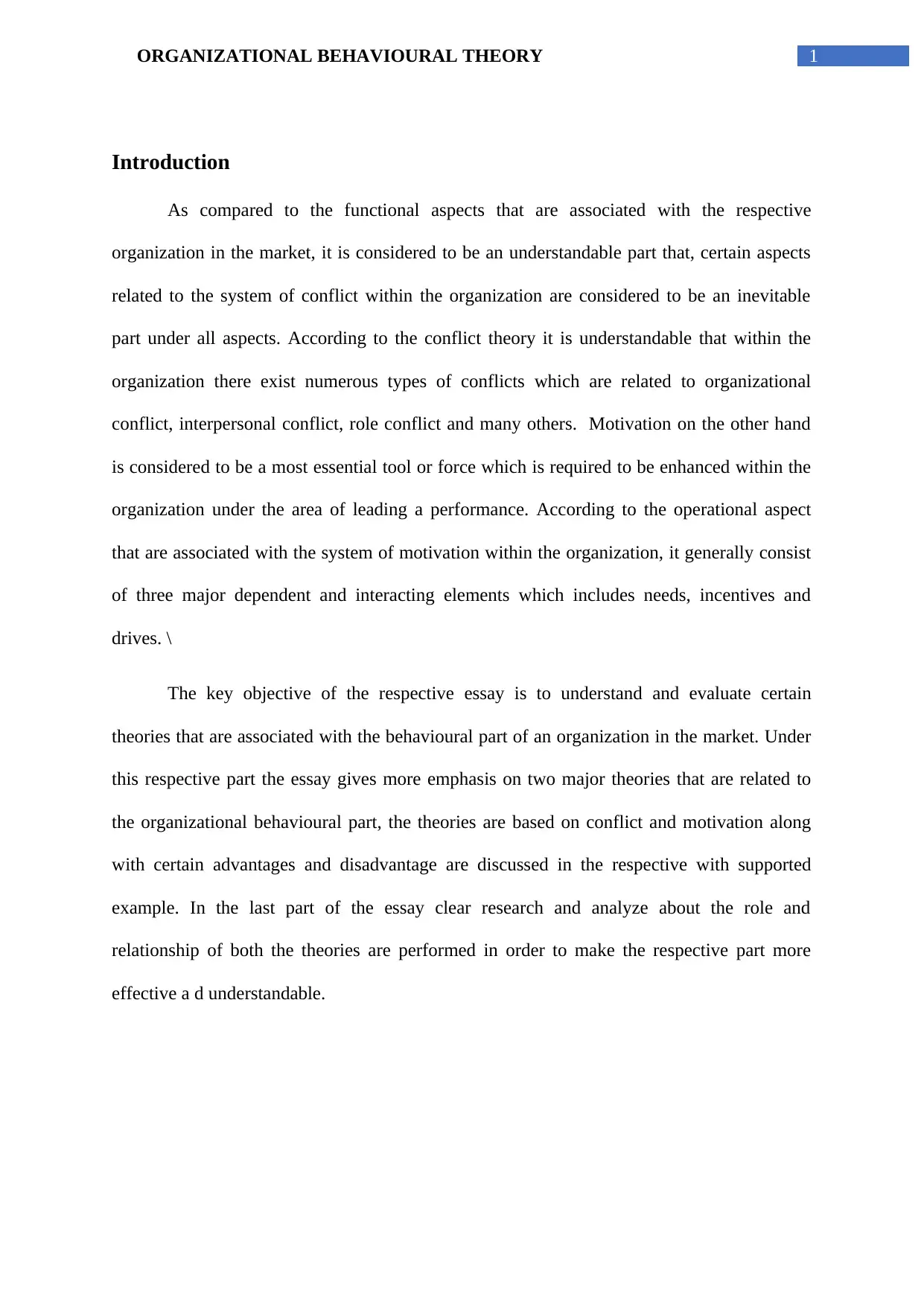
1ORGANIZATIONAL BEHAVIOURAL THEORY
Introduction
As compared to the functional aspects that are associated with the respective
organization in the market, it is considered to be an understandable part that, certain aspects
related to the system of conflict within the organization are considered to be an inevitable
part under all aspects. According to the conflict theory it is understandable that within the
organization there exist numerous types of conflicts which are related to organizational
conflict, interpersonal conflict, role conflict and many others. Motivation on the other hand
is considered to be a most essential tool or force which is required to be enhanced within the
organization under the area of leading a performance. According to the operational aspect
that are associated with the system of motivation within the organization, it generally consist
of three major dependent and interacting elements which includes needs, incentives and
drives. \
The key objective of the respective essay is to understand and evaluate certain
theories that are associated with the behavioural part of an organization in the market. Under
this respective part the essay gives more emphasis on two major theories that are related to
the organizational behavioural part, the theories are based on conflict and motivation along
with certain advantages and disadvantage are discussed in the respective with supported
example. In the last part of the essay clear research and analyze about the role and
relationship of both the theories are performed in order to make the respective part more
effective a d understandable.
Introduction
As compared to the functional aspects that are associated with the respective
organization in the market, it is considered to be an understandable part that, certain aspects
related to the system of conflict within the organization are considered to be an inevitable
part under all aspects. According to the conflict theory it is understandable that within the
organization there exist numerous types of conflicts which are related to organizational
conflict, interpersonal conflict, role conflict and many others. Motivation on the other hand
is considered to be a most essential tool or force which is required to be enhanced within the
organization under the area of leading a performance. According to the operational aspect
that are associated with the system of motivation within the organization, it generally consist
of three major dependent and interacting elements which includes needs, incentives and
drives. \
The key objective of the respective essay is to understand and evaluate certain
theories that are associated with the behavioural part of an organization in the market. Under
this respective part the essay gives more emphasis on two major theories that are related to
the organizational behavioural part, the theories are based on conflict and motivation along
with certain advantages and disadvantage are discussed in the respective with supported
example. In the last part of the essay clear research and analyze about the role and
relationship of both the theories are performed in order to make the respective part more
effective a d understandable.
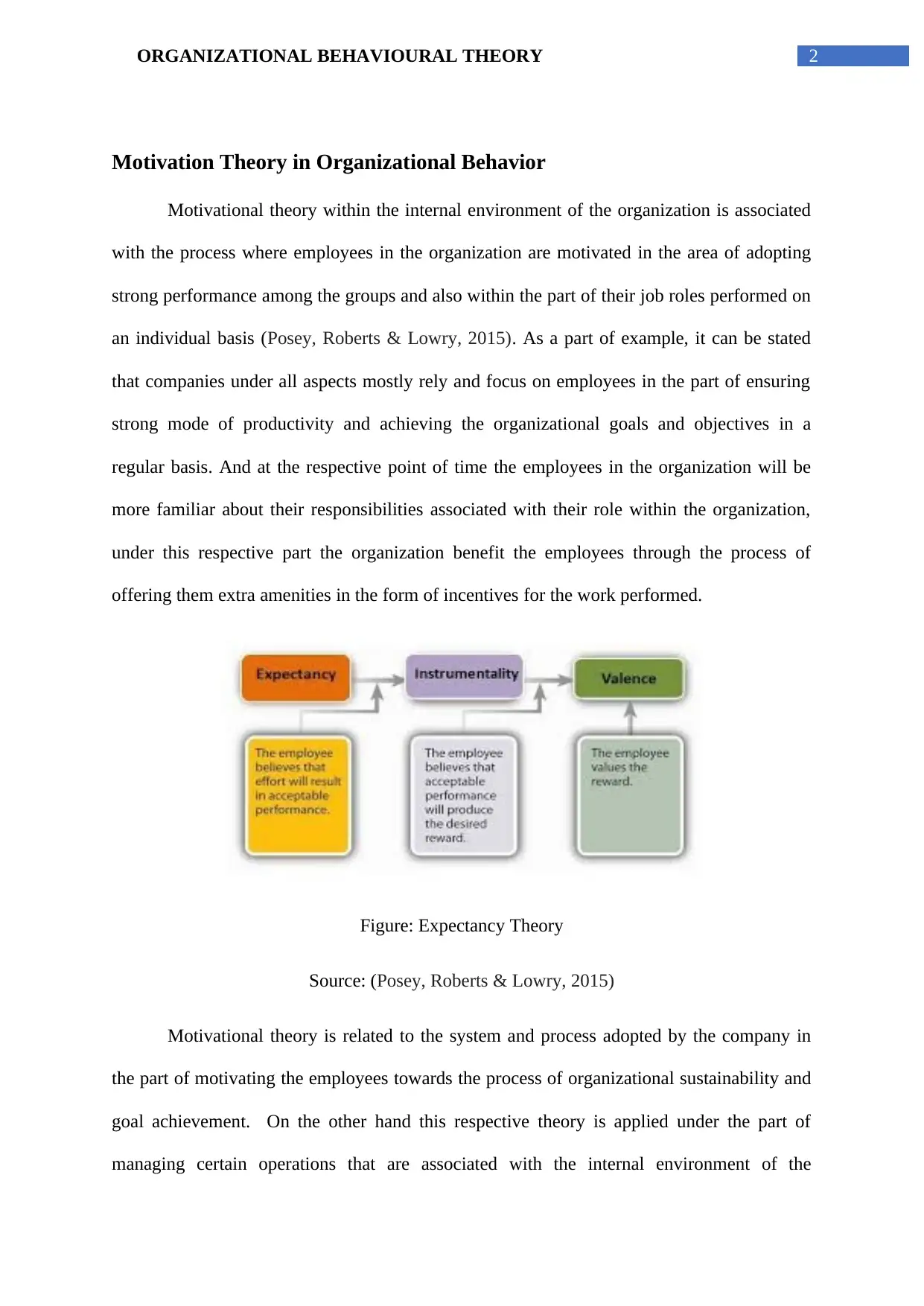
2ORGANIZATIONAL BEHAVIOURAL THEORY
Motivation Theory in Organizational Behavior
Motivational theory within the internal environment of the organization is associated
with the process where employees in the organization are motivated in the area of adopting
strong performance among the groups and also within the part of their job roles performed on
an individual basis (Posey, Roberts & Lowry, 2015). As a part of example, it can be stated
that companies under all aspects mostly rely and focus on employees in the part of ensuring
strong mode of productivity and achieving the organizational goals and objectives in a
regular basis. And at the respective point of time the employees in the organization will be
more familiar about their responsibilities associated with their role within the organization,
under this respective part the organization benefit the employees through the process of
offering them extra amenities in the form of incentives for the work performed.
Figure: Expectancy Theory
Source: (Posey, Roberts & Lowry, 2015)
Motivational theory is related to the system and process adopted by the company in
the part of motivating the employees towards the process of organizational sustainability and
goal achievement. On the other hand this respective theory is applied under the part of
managing certain operations that are associated with the internal environment of the
Motivation Theory in Organizational Behavior
Motivational theory within the internal environment of the organization is associated
with the process where employees in the organization are motivated in the area of adopting
strong performance among the groups and also within the part of their job roles performed on
an individual basis (Posey, Roberts & Lowry, 2015). As a part of example, it can be stated
that companies under all aspects mostly rely and focus on employees in the part of ensuring
strong mode of productivity and achieving the organizational goals and objectives in a
regular basis. And at the respective point of time the employees in the organization will be
more familiar about their responsibilities associated with their role within the organization,
under this respective part the organization benefit the employees through the process of
offering them extra amenities in the form of incentives for the work performed.
Figure: Expectancy Theory
Source: (Posey, Roberts & Lowry, 2015)
Motivational theory is related to the system and process adopted by the company in
the part of motivating the employees towards the process of organizational sustainability and
goal achievement. On the other hand this respective theory is applied under the part of
managing certain operations that are associated with the internal environment of the
⊘ This is a preview!⊘
Do you want full access?
Subscribe today to unlock all pages.

Trusted by 1+ million students worldwide
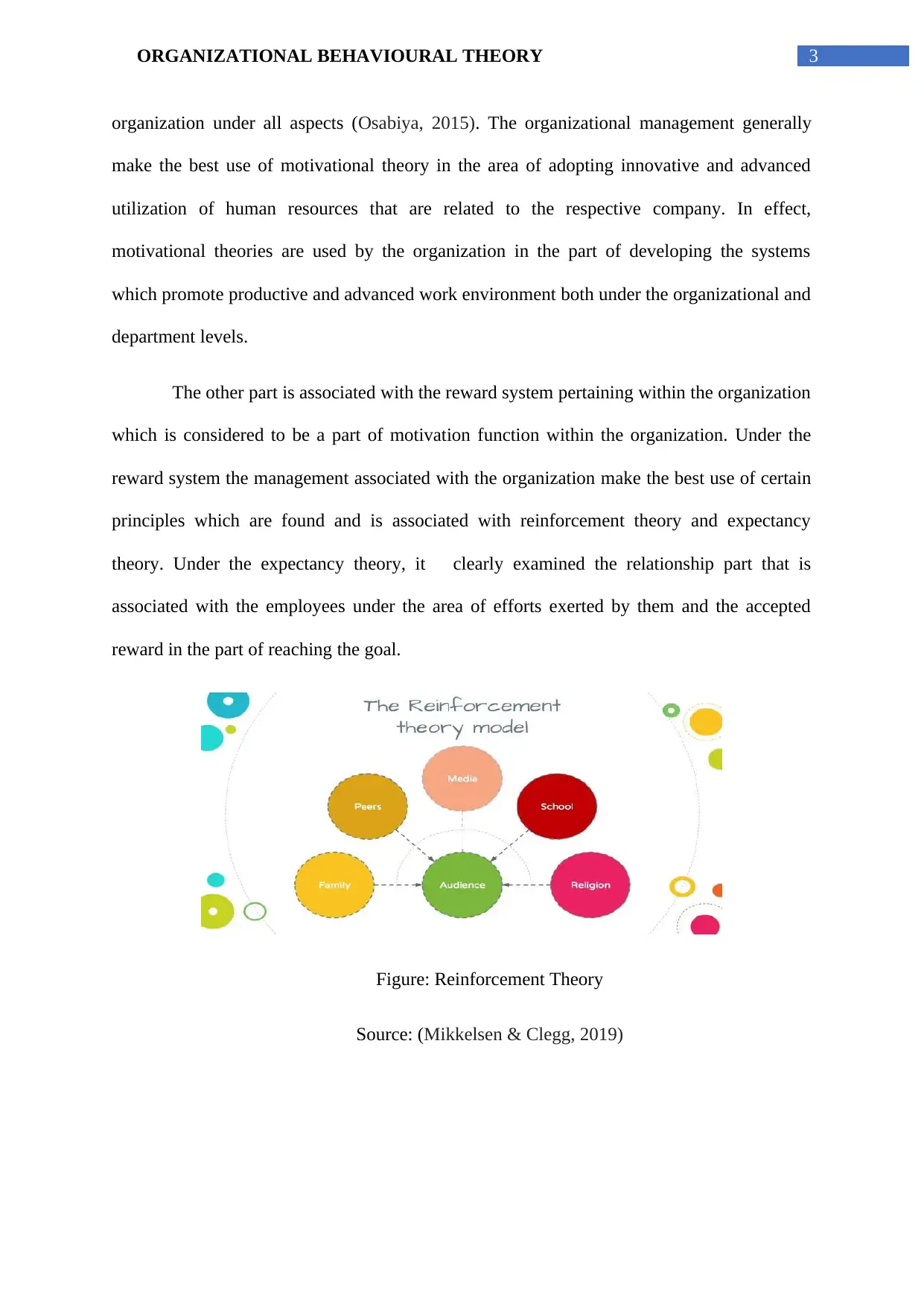
3ORGANIZATIONAL BEHAVIOURAL THEORY
organization under all aspects (Osabiya, 2015). The organizational management generally
make the best use of motivational theory in the area of adopting innovative and advanced
utilization of human resources that are related to the respective company. In effect,
motivational theories are used by the organization in the part of developing the systems
which promote productive and advanced work environment both under the organizational and
department levels.
The other part is associated with the reward system pertaining within the organization
which is considered to be a part of motivation function within the organization. Under the
reward system the management associated with the organization make the best use of certain
principles which are found and is associated with reinforcement theory and expectancy
theory. Under the expectancy theory, it clearly examined the relationship part that is
associated with the employees under the area of efforts exerted by them and the accepted
reward in the part of reaching the goal.
Figure: Reinforcement Theory
Source: (Mikkelsen & Clegg, 2019)
organization under all aspects (Osabiya, 2015). The organizational management generally
make the best use of motivational theory in the area of adopting innovative and advanced
utilization of human resources that are related to the respective company. In effect,
motivational theories are used by the organization in the part of developing the systems
which promote productive and advanced work environment both under the organizational and
department levels.
The other part is associated with the reward system pertaining within the organization
which is considered to be a part of motivation function within the organization. Under the
reward system the management associated with the organization make the best use of certain
principles which are found and is associated with reinforcement theory and expectancy
theory. Under the expectancy theory, it clearly examined the relationship part that is
associated with the employees under the area of efforts exerted by them and the accepted
reward in the part of reaching the goal.
Figure: Reinforcement Theory
Source: (Mikkelsen & Clegg, 2019)
Paraphrase This Document
Need a fresh take? Get an instant paraphrase of this document with our AI Paraphraser
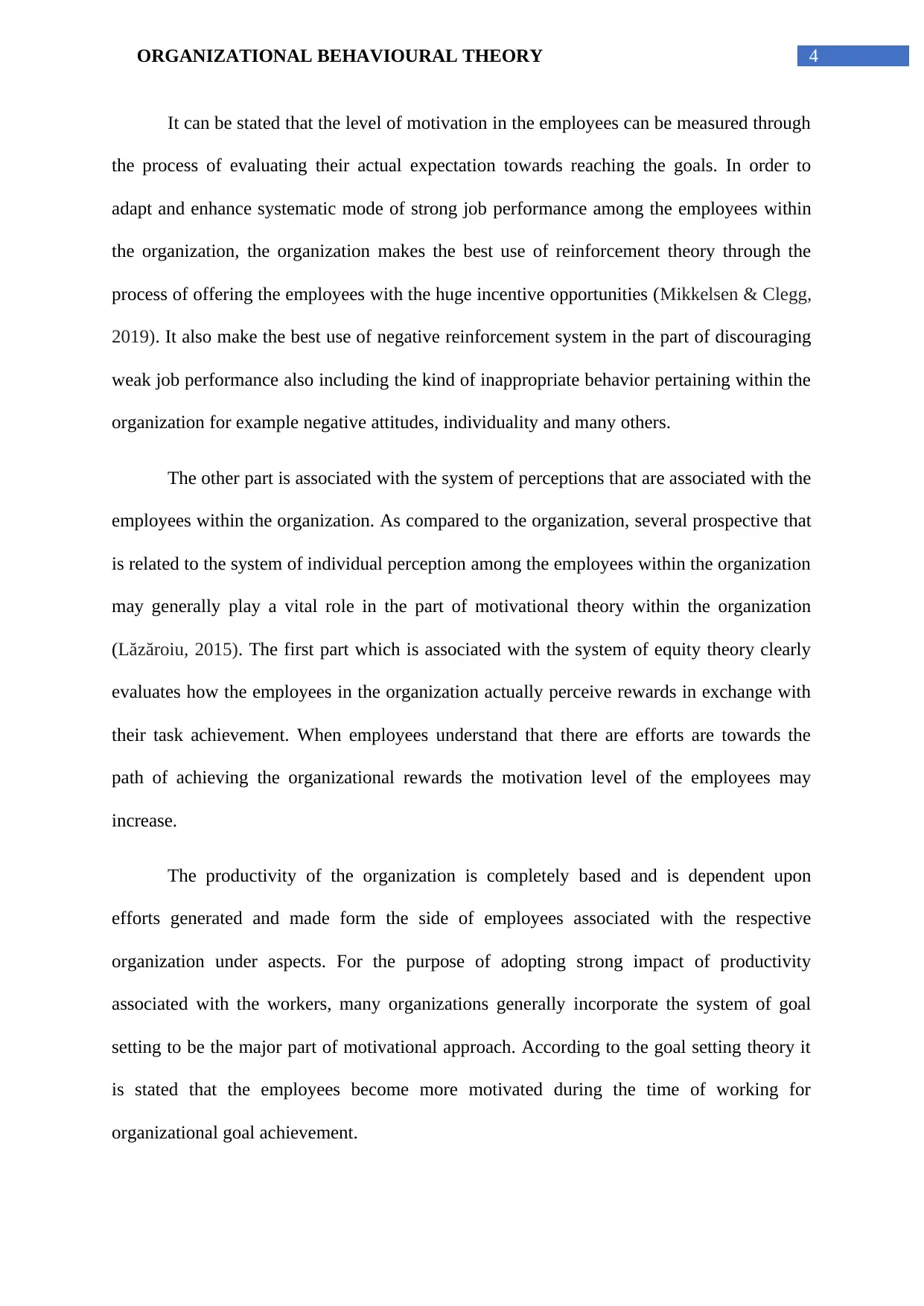
4ORGANIZATIONAL BEHAVIOURAL THEORY
It can be stated that the level of motivation in the employees can be measured through
the process of evaluating their actual expectation towards reaching the goals. In order to
adapt and enhance systematic mode of strong job performance among the employees within
the organization, the organization makes the best use of reinforcement theory through the
process of offering the employees with the huge incentive opportunities (Mikkelsen & Clegg,
2019). It also make the best use of negative reinforcement system in the part of discouraging
weak job performance also including the kind of inappropriate behavior pertaining within the
organization for example negative attitudes, individuality and many others.
The other part is associated with the system of perceptions that are associated with the
employees within the organization. As compared to the organization, several prospective that
is related to the system of individual perception among the employees within the organization
may generally play a vital role in the part of motivational theory within the organization
(Lăzăroiu, 2015). The first part which is associated with the system of equity theory clearly
evaluates how the employees in the organization actually perceive rewards in exchange with
their task achievement. When employees understand that there are efforts are towards the
path of achieving the organizational rewards the motivation level of the employees may
increase.
The productivity of the organization is completely based and is dependent upon
efforts generated and made form the side of employees associated with the respective
organization under aspects. For the purpose of adopting strong impact of productivity
associated with the workers, many organizations generally incorporate the system of goal
setting to be the major part of motivational approach. According to the goal setting theory it
is stated that the employees become more motivated during the time of working for
organizational goal achievement.
It can be stated that the level of motivation in the employees can be measured through
the process of evaluating their actual expectation towards reaching the goals. In order to
adapt and enhance systematic mode of strong job performance among the employees within
the organization, the organization makes the best use of reinforcement theory through the
process of offering the employees with the huge incentive opportunities (Mikkelsen & Clegg,
2019). It also make the best use of negative reinforcement system in the part of discouraging
weak job performance also including the kind of inappropriate behavior pertaining within the
organization for example negative attitudes, individuality and many others.
The other part is associated with the system of perceptions that are associated with the
employees within the organization. As compared to the organization, several prospective that
is related to the system of individual perception among the employees within the organization
may generally play a vital role in the part of motivational theory within the organization
(Lăzăroiu, 2015). The first part which is associated with the system of equity theory clearly
evaluates how the employees in the organization actually perceive rewards in exchange with
their task achievement. When employees understand that there are efforts are towards the
path of achieving the organizational rewards the motivation level of the employees may
increase.
The productivity of the organization is completely based and is dependent upon
efforts generated and made form the side of employees associated with the respective
organization under aspects. For the purpose of adopting strong impact of productivity
associated with the workers, many organizations generally incorporate the system of goal
setting to be the major part of motivational approach. According to the goal setting theory it
is stated that the employees become more motivated during the time of working for
organizational goal achievement.
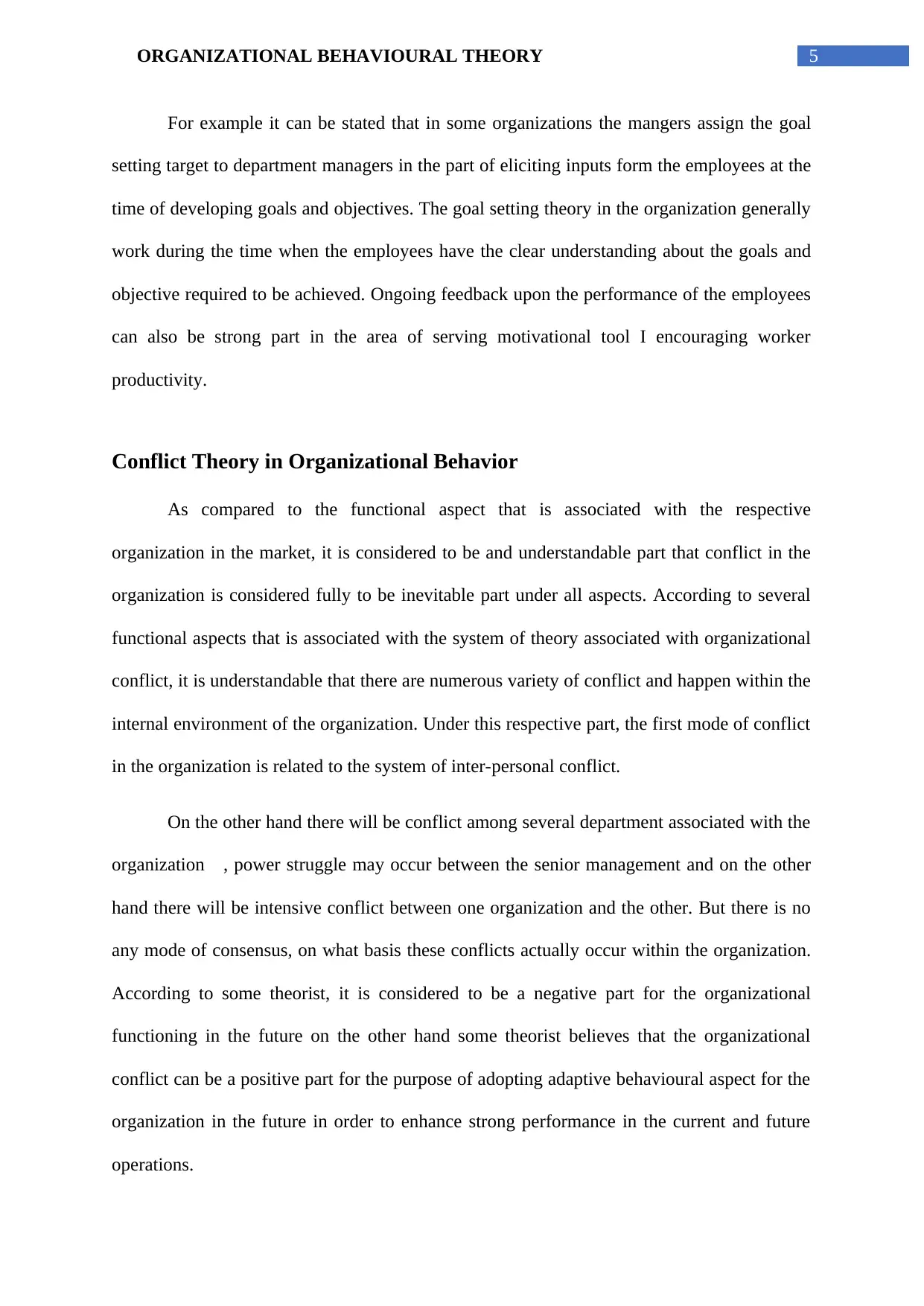
5ORGANIZATIONAL BEHAVIOURAL THEORY
For example it can be stated that in some organizations the mangers assign the goal
setting target to department managers in the part of eliciting inputs form the employees at the
time of developing goals and objectives. The goal setting theory in the organization generally
work during the time when the employees have the clear understanding about the goals and
objective required to be achieved. Ongoing feedback upon the performance of the employees
can also be strong part in the area of serving motivational tool I encouraging worker
productivity.
Conflict Theory in Organizational Behavior
As compared to the functional aspect that is associated with the respective
organization in the market, it is considered to be and understandable part that conflict in the
organization is considered fully to be inevitable part under all aspects. According to several
functional aspects that is associated with the system of theory associated with organizational
conflict, it is understandable that there are numerous variety of conflict and happen within the
internal environment of the organization. Under this respective part, the first mode of conflict
in the organization is related to the system of inter-personal conflict.
On the other hand there will be conflict among several department associated with the
organization , power struggle may occur between the senior management and on the other
hand there will be intensive conflict between one organization and the other. But there is no
any mode of consensus, on what basis these conflicts actually occur within the organization.
According to some theorist, it is considered to be a negative part for the organizational
functioning in the future on the other hand some theorist believes that the organizational
conflict can be a positive part for the purpose of adopting adaptive behavioural aspect for the
organization in the future in order to enhance strong performance in the current and future
operations.
For example it can be stated that in some organizations the mangers assign the goal
setting target to department managers in the part of eliciting inputs form the employees at the
time of developing goals and objectives. The goal setting theory in the organization generally
work during the time when the employees have the clear understanding about the goals and
objective required to be achieved. Ongoing feedback upon the performance of the employees
can also be strong part in the area of serving motivational tool I encouraging worker
productivity.
Conflict Theory in Organizational Behavior
As compared to the functional aspect that is associated with the respective
organization in the market, it is considered to be and understandable part that conflict in the
organization is considered fully to be inevitable part under all aspects. According to several
functional aspects that is associated with the system of theory associated with organizational
conflict, it is understandable that there are numerous variety of conflict and happen within the
internal environment of the organization. Under this respective part, the first mode of conflict
in the organization is related to the system of inter-personal conflict.
On the other hand there will be conflict among several department associated with the
organization , power struggle may occur between the senior management and on the other
hand there will be intensive conflict between one organization and the other. But there is no
any mode of consensus, on what basis these conflicts actually occur within the organization.
According to some theorist, it is considered to be a negative part for the organizational
functioning in the future on the other hand some theorist believes that the organizational
conflict can be a positive part for the purpose of adopting adaptive behavioural aspect for the
organization in the future in order to enhance strong performance in the current and future
operations.
⊘ This is a preview!⊘
Do you want full access?
Subscribe today to unlock all pages.

Trusted by 1+ million students worldwide
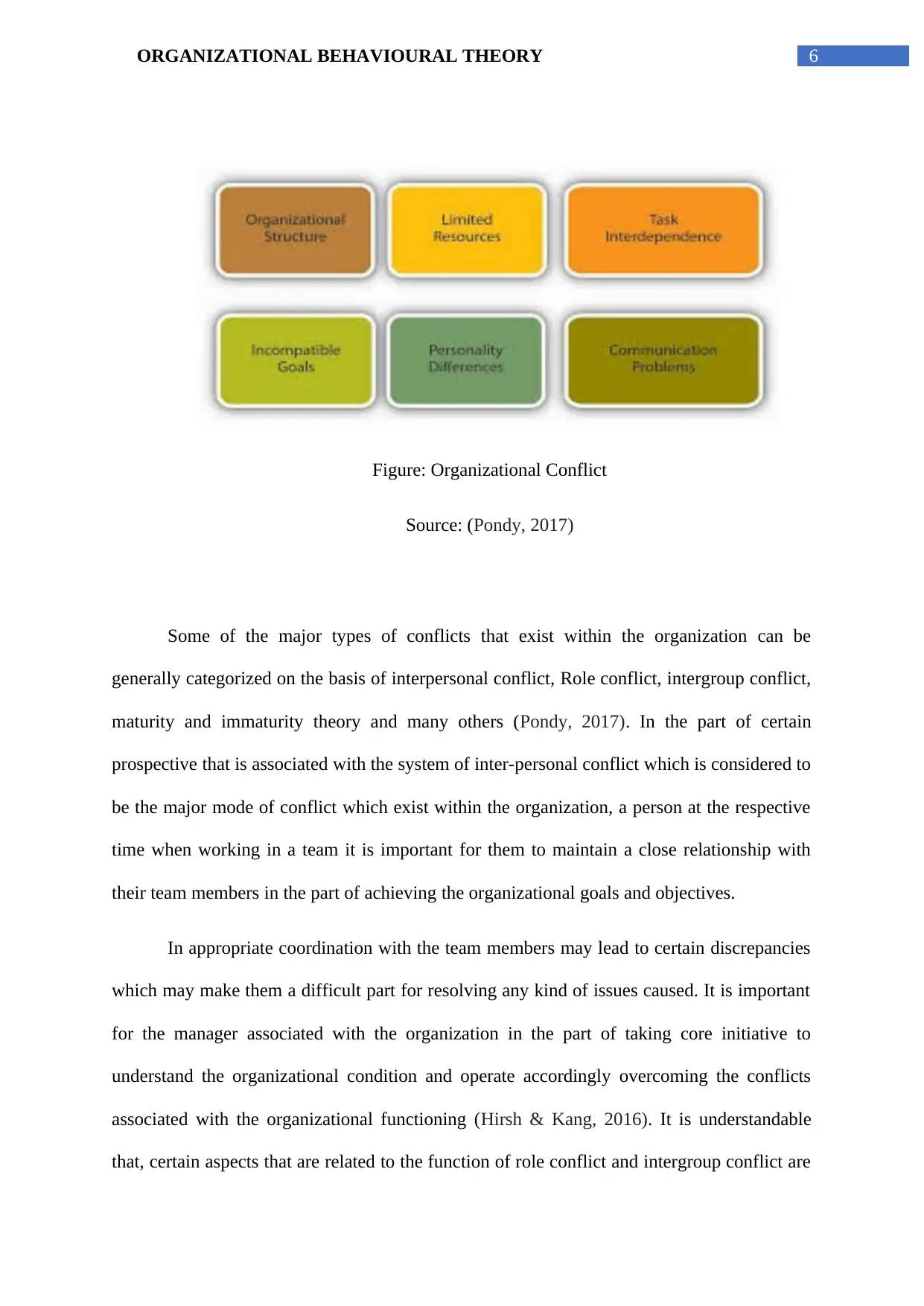
6ORGANIZATIONAL BEHAVIOURAL THEORY
Figure: Organizational Conflict
Source: (Pondy, 2017)
Some of the major types of conflicts that exist within the organization can be
generally categorized on the basis of interpersonal conflict, Role conflict, intergroup conflict,
maturity and immaturity theory and many others (Pondy, 2017). In the part of certain
prospective that is associated with the system of inter-personal conflict which is considered to
be the major mode of conflict which exist within the organization, a person at the respective
time when working in a team it is important for them to maintain a close relationship with
their team members in the part of achieving the organizational goals and objectives.
In appropriate coordination with the team members may lead to certain discrepancies
which may make them a difficult part for resolving any kind of issues caused. It is important
for the manager associated with the organization in the part of taking core initiative to
understand the organizational condition and operate accordingly overcoming the conflicts
associated with the organizational functioning (Hirsh & Kang, 2016). It is understandable
that, certain aspects that are related to the function of role conflict and intergroup conflict are
Figure: Organizational Conflict
Source: (Pondy, 2017)
Some of the major types of conflicts that exist within the organization can be
generally categorized on the basis of interpersonal conflict, Role conflict, intergroup conflict,
maturity and immaturity theory and many others (Pondy, 2017). In the part of certain
prospective that is associated with the system of inter-personal conflict which is considered to
be the major mode of conflict which exist within the organization, a person at the respective
time when working in a team it is important for them to maintain a close relationship with
their team members in the part of achieving the organizational goals and objectives.
In appropriate coordination with the team members may lead to certain discrepancies
which may make them a difficult part for resolving any kind of issues caused. It is important
for the manager associated with the organization in the part of taking core initiative to
understand the organizational condition and operate accordingly overcoming the conflicts
associated with the organizational functioning (Hirsh & Kang, 2016). It is understandable
that, certain aspects that are related to the function of role conflict and intergroup conflict are
Paraphrase This Document
Need a fresh take? Get an instant paraphrase of this document with our AI Paraphraser
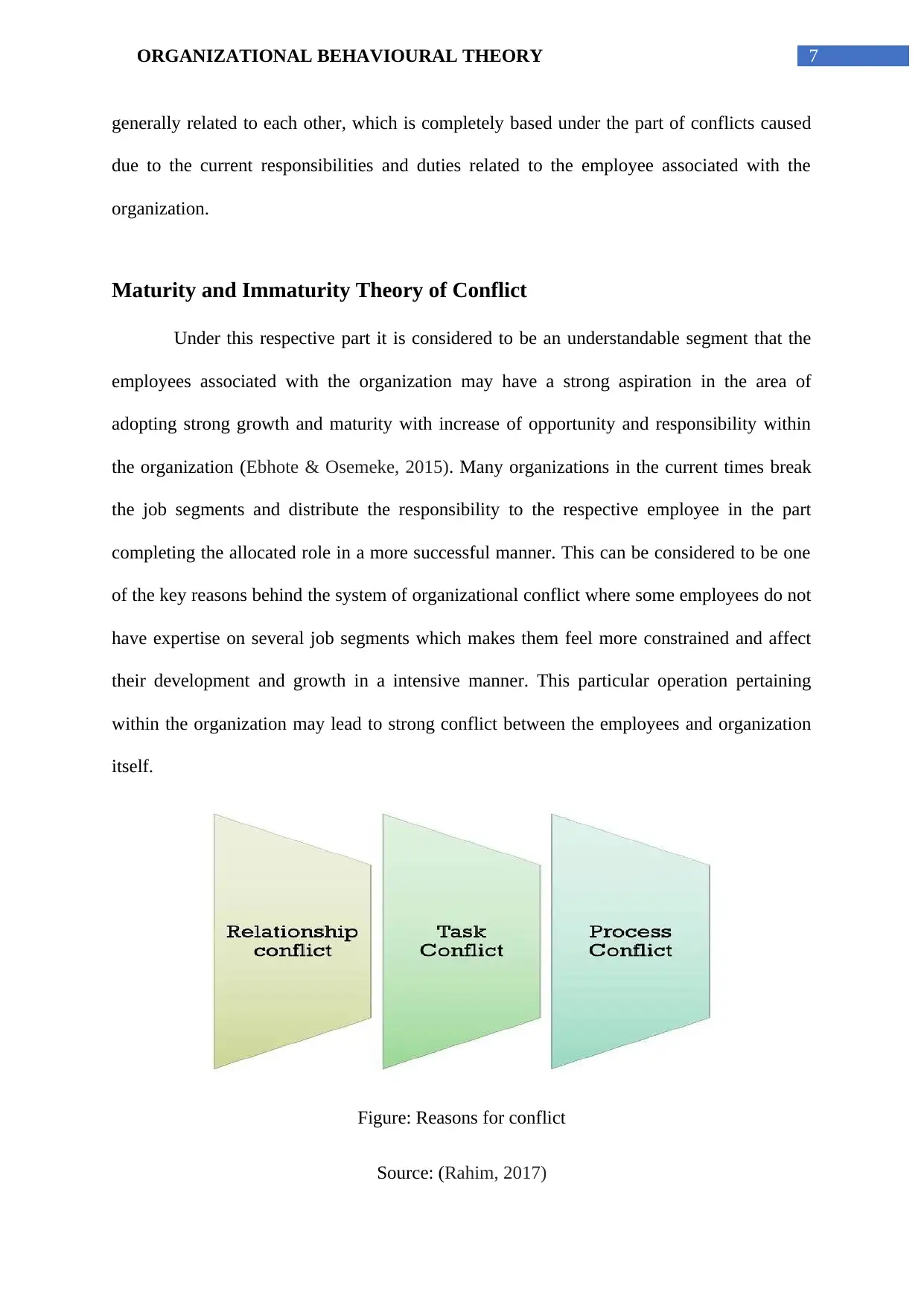
7ORGANIZATIONAL BEHAVIOURAL THEORY
generally related to each other, which is completely based under the part of conflicts caused
due to the current responsibilities and duties related to the employee associated with the
organization.
Maturity and Immaturity Theory of Conflict
Under this respective part it is considered to be an understandable segment that the
employees associated with the organization may have a strong aspiration in the area of
adopting strong growth and maturity with increase of opportunity and responsibility within
the organization (Ebhote & Osemeke, 2015). Many organizations in the current times break
the job segments and distribute the responsibility to the respective employee in the part
completing the allocated role in a more successful manner. This can be considered to be one
of the key reasons behind the system of organizational conflict where some employees do not
have expertise on several job segments which makes them feel more constrained and affect
their development and growth in a intensive manner. This particular operation pertaining
within the organization may lead to strong conflict between the employees and organization
itself.
Figure: Reasons for conflict
Source: (Rahim, 2017)
generally related to each other, which is completely based under the part of conflicts caused
due to the current responsibilities and duties related to the employee associated with the
organization.
Maturity and Immaturity Theory of Conflict
Under this respective part it is considered to be an understandable segment that the
employees associated with the organization may have a strong aspiration in the area of
adopting strong growth and maturity with increase of opportunity and responsibility within
the organization (Ebhote & Osemeke, 2015). Many organizations in the current times break
the job segments and distribute the responsibility to the respective employee in the part
completing the allocated role in a more successful manner. This can be considered to be one
of the key reasons behind the system of organizational conflict where some employees do not
have expertise on several job segments which makes them feel more constrained and affect
their development and growth in a intensive manner. This particular operation pertaining
within the organization may lead to strong conflict between the employees and organization
itself.
Figure: Reasons for conflict
Source: (Rahim, 2017)
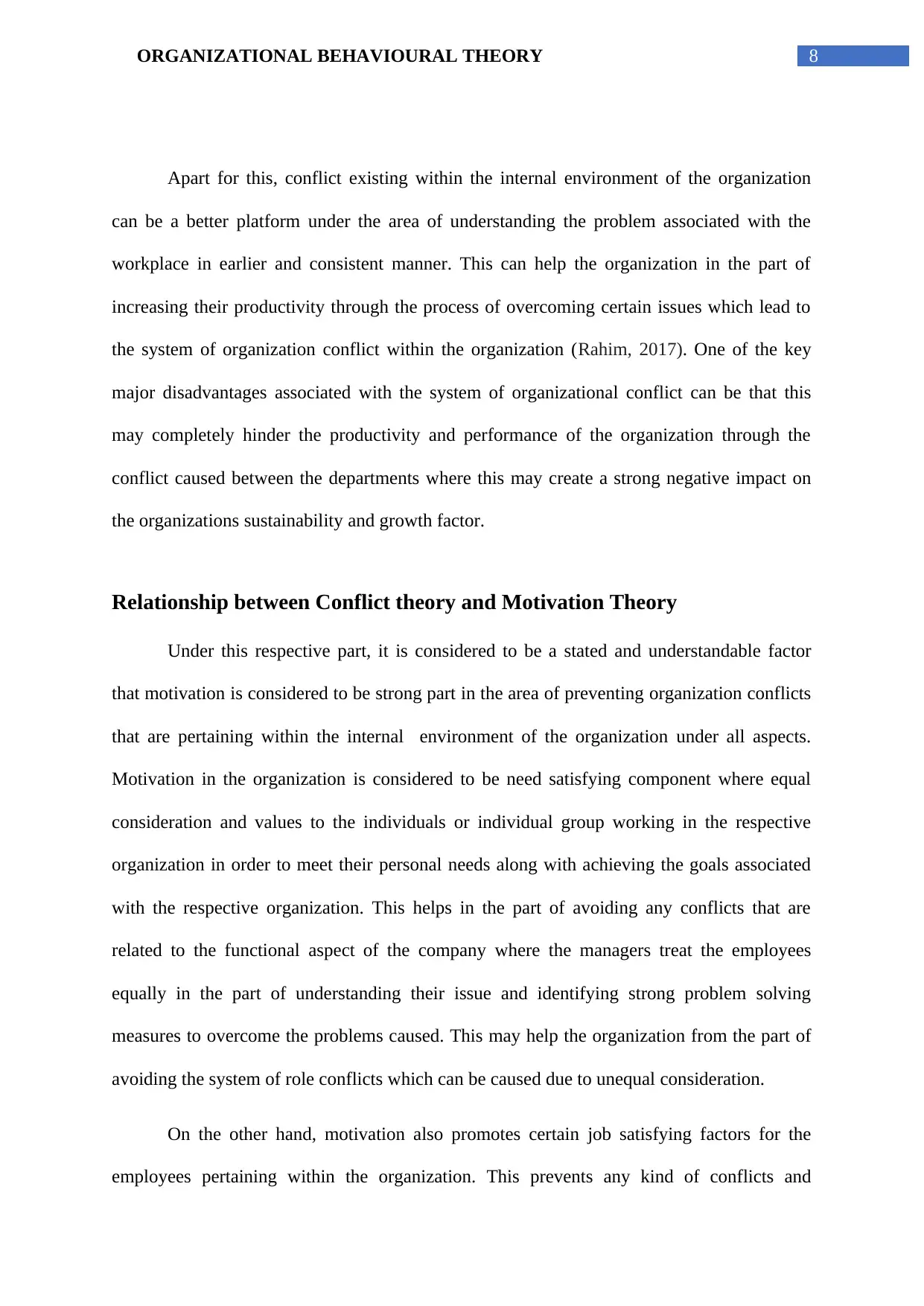
8ORGANIZATIONAL BEHAVIOURAL THEORY
Apart for this, conflict existing within the internal environment of the organization
can be a better platform under the area of understanding the problem associated with the
workplace in earlier and consistent manner. This can help the organization in the part of
increasing their productivity through the process of overcoming certain issues which lead to
the system of organization conflict within the organization (Rahim, 2017). One of the key
major disadvantages associated with the system of organizational conflict can be that this
may completely hinder the productivity and performance of the organization through the
conflict caused between the departments where this may create a strong negative impact on
the organizations sustainability and growth factor.
Relationship between Conflict theory and Motivation Theory
Under this respective part, it is considered to be a stated and understandable factor
that motivation is considered to be strong part in the area of preventing organization conflicts
that are pertaining within the internal environment of the organization under all aspects.
Motivation in the organization is considered to be need satisfying component where equal
consideration and values to the individuals or individual group working in the respective
organization in order to meet their personal needs along with achieving the goals associated
with the respective organization. This helps in the part of avoiding any conflicts that are
related to the functional aspect of the company where the managers treat the employees
equally in the part of understanding their issue and identifying strong problem solving
measures to overcome the problems caused. This may help the organization from the part of
avoiding the system of role conflicts which can be caused due to unequal consideration.
On the other hand, motivation also promotes certain job satisfying factors for the
employees pertaining within the organization. This prevents any kind of conflicts and
Apart for this, conflict existing within the internal environment of the organization
can be a better platform under the area of understanding the problem associated with the
workplace in earlier and consistent manner. This can help the organization in the part of
increasing their productivity through the process of overcoming certain issues which lead to
the system of organization conflict within the organization (Rahim, 2017). One of the key
major disadvantages associated with the system of organizational conflict can be that this
may completely hinder the productivity and performance of the organization through the
conflict caused between the departments where this may create a strong negative impact on
the organizations sustainability and growth factor.
Relationship between Conflict theory and Motivation Theory
Under this respective part, it is considered to be a stated and understandable factor
that motivation is considered to be strong part in the area of preventing organization conflicts
that are pertaining within the internal environment of the organization under all aspects.
Motivation in the organization is considered to be need satisfying component where equal
consideration and values to the individuals or individual group working in the respective
organization in order to meet their personal needs along with achieving the goals associated
with the respective organization. This helps in the part of avoiding any conflicts that are
related to the functional aspect of the company where the managers treat the employees
equally in the part of understanding their issue and identifying strong problem solving
measures to overcome the problems caused. This may help the organization from the part of
avoiding the system of role conflicts which can be caused due to unequal consideration.
On the other hand, motivation also promotes certain job satisfying factors for the
employees pertaining within the organization. This prevents any kind of conflicts and
⊘ This is a preview!⊘
Do you want full access?
Subscribe today to unlock all pages.

Trusted by 1+ million students worldwide
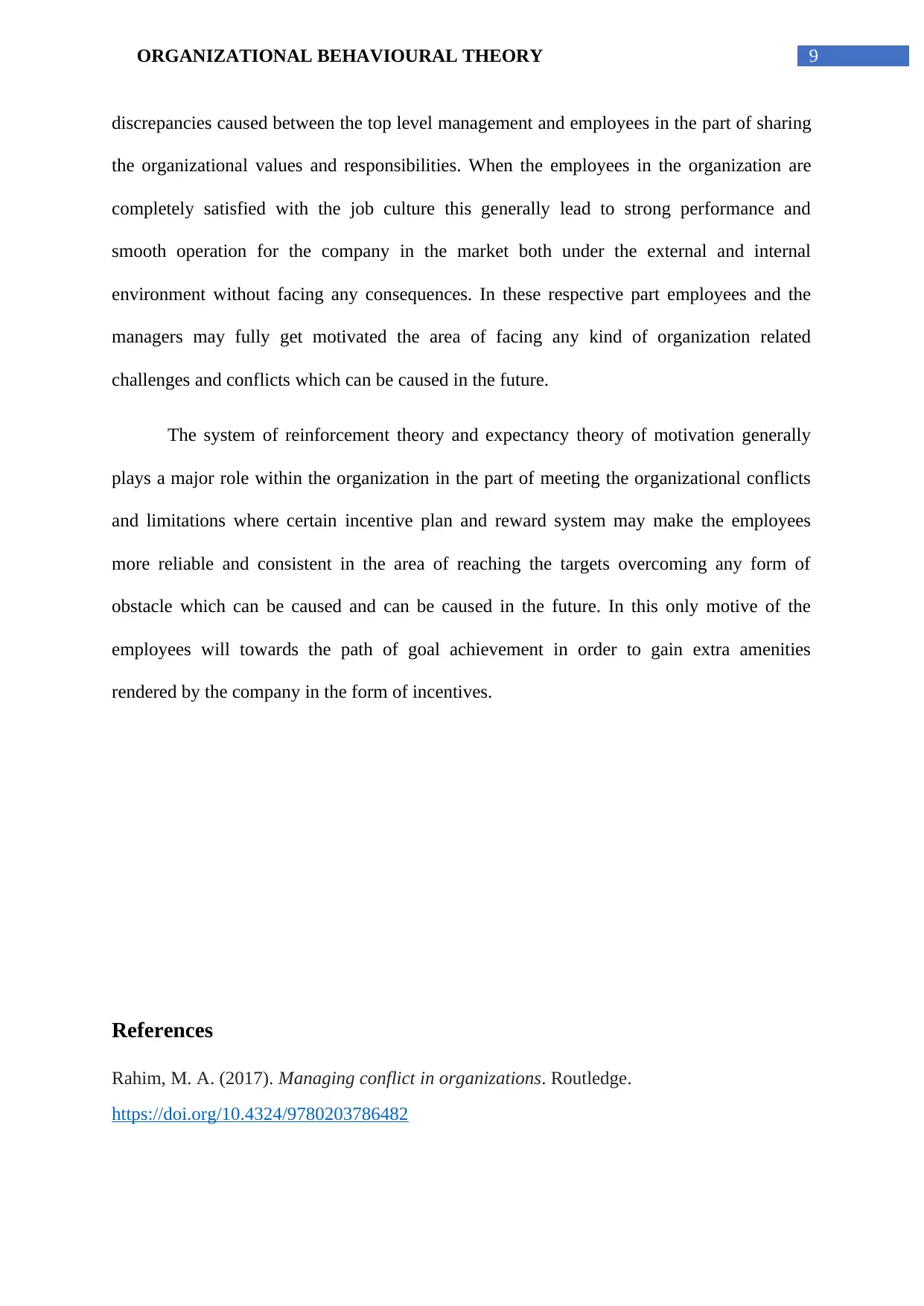
9ORGANIZATIONAL BEHAVIOURAL THEORY
discrepancies caused between the top level management and employees in the part of sharing
the organizational values and responsibilities. When the employees in the organization are
completely satisfied with the job culture this generally lead to strong performance and
smooth operation for the company in the market both under the external and internal
environment without facing any consequences. In these respective part employees and the
managers may fully get motivated the area of facing any kind of organization related
challenges and conflicts which can be caused in the future.
The system of reinforcement theory and expectancy theory of motivation generally
plays a major role within the organization in the part of meeting the organizational conflicts
and limitations where certain incentive plan and reward system may make the employees
more reliable and consistent in the area of reaching the targets overcoming any form of
obstacle which can be caused and can be caused in the future. In this only motive of the
employees will towards the path of goal achievement in order to gain extra amenities
rendered by the company in the form of incentives.
References
Rahim, M. A. (2017). Managing conflict in organizations. Routledge.
https://doi.org/10.4324/9780203786482
discrepancies caused between the top level management and employees in the part of sharing
the organizational values and responsibilities. When the employees in the organization are
completely satisfied with the job culture this generally lead to strong performance and
smooth operation for the company in the market both under the external and internal
environment without facing any consequences. In these respective part employees and the
managers may fully get motivated the area of facing any kind of organization related
challenges and conflicts which can be caused in the future.
The system of reinforcement theory and expectancy theory of motivation generally
plays a major role within the organization in the part of meeting the organizational conflicts
and limitations where certain incentive plan and reward system may make the employees
more reliable and consistent in the area of reaching the targets overcoming any form of
obstacle which can be caused and can be caused in the future. In this only motive of the
employees will towards the path of goal achievement in order to gain extra amenities
rendered by the company in the form of incentives.
References
Rahim, M. A. (2017). Managing conflict in organizations. Routledge.
https://doi.org/10.4324/9780203786482
Paraphrase This Document
Need a fresh take? Get an instant paraphrase of this document with our AI Paraphraser
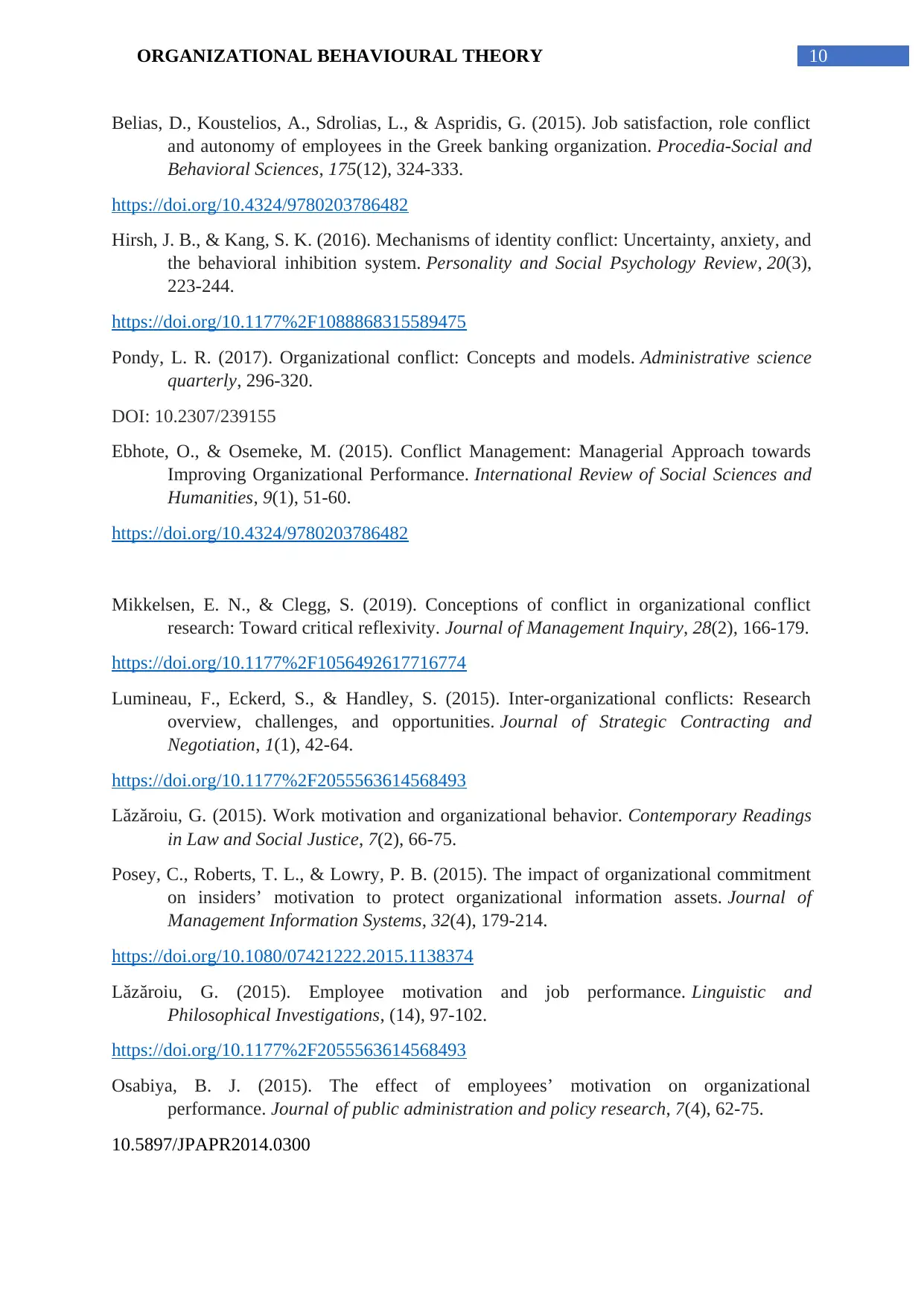
10ORGANIZATIONAL BEHAVIOURAL THEORY
Belias, D., Koustelios, A., Sdrolias, L., & Aspridis, G. (2015). Job satisfaction, role conflict
and autonomy of employees in the Greek banking organization. Procedia-Social and
Behavioral Sciences, 175(12), 324-333.
https://doi.org/10.4324/9780203786482
Hirsh, J. B., & Kang, S. K. (2016). Mechanisms of identity conflict: Uncertainty, anxiety, and
the behavioral inhibition system. Personality and Social Psychology Review, 20(3),
223-244.
https://doi.org/10.1177%2F1088868315589475
Pondy, L. R. (2017). Organizational conflict: Concepts and models. Administrative science
quarterly, 296-320.
DOI: 10.2307/239155
Ebhote, O., & Osemeke, M. (2015). Conflict Management: Managerial Approach towards
Improving Organizational Performance. International Review of Social Sciences and
Humanities, 9(1), 51-60.
https://doi.org/10.4324/9780203786482
Mikkelsen, E. N., & Clegg, S. (2019). Conceptions of conflict in organizational conflict
research: Toward critical reflexivity. Journal of Management Inquiry, 28(2), 166-179.
https://doi.org/10.1177%2F1056492617716774
Lumineau, F., Eckerd, S., & Handley, S. (2015). Inter-organizational conflicts: Research
overview, challenges, and opportunities. Journal of Strategic Contracting and
Negotiation, 1(1), 42-64.
https://doi.org/10.1177%2F2055563614568493
Lăzăroiu, G. (2015). Work motivation and organizational behavior. Contemporary Readings
in Law and Social Justice, 7(2), 66-75.
Posey, C., Roberts, T. L., & Lowry, P. B. (2015). The impact of organizational commitment
on insiders’ motivation to protect organizational information assets. Journal of
Management Information Systems, 32(4), 179-214.
https://doi.org/10.1080/07421222.2015.1138374
Lăzăroiu, G. (2015). Employee motivation and job performance. Linguistic and
Philosophical Investigations, (14), 97-102.
https://doi.org/10.1177%2F2055563614568493
Osabiya, B. J. (2015). The effect of employees’ motivation on organizational
performance. Journal of public administration and policy research, 7(4), 62-75.
10.5897/JPAPR2014.0300
Belias, D., Koustelios, A., Sdrolias, L., & Aspridis, G. (2015). Job satisfaction, role conflict
and autonomy of employees in the Greek banking organization. Procedia-Social and
Behavioral Sciences, 175(12), 324-333.
https://doi.org/10.4324/9780203786482
Hirsh, J. B., & Kang, S. K. (2016). Mechanisms of identity conflict: Uncertainty, anxiety, and
the behavioral inhibition system. Personality and Social Psychology Review, 20(3),
223-244.
https://doi.org/10.1177%2F1088868315589475
Pondy, L. R. (2017). Organizational conflict: Concepts and models. Administrative science
quarterly, 296-320.
DOI: 10.2307/239155
Ebhote, O., & Osemeke, M. (2015). Conflict Management: Managerial Approach towards
Improving Organizational Performance. International Review of Social Sciences and
Humanities, 9(1), 51-60.
https://doi.org/10.4324/9780203786482
Mikkelsen, E. N., & Clegg, S. (2019). Conceptions of conflict in organizational conflict
research: Toward critical reflexivity. Journal of Management Inquiry, 28(2), 166-179.
https://doi.org/10.1177%2F1056492617716774
Lumineau, F., Eckerd, S., & Handley, S. (2015). Inter-organizational conflicts: Research
overview, challenges, and opportunities. Journal of Strategic Contracting and
Negotiation, 1(1), 42-64.
https://doi.org/10.1177%2F2055563614568493
Lăzăroiu, G. (2015). Work motivation and organizational behavior. Contemporary Readings
in Law and Social Justice, 7(2), 66-75.
Posey, C., Roberts, T. L., & Lowry, P. B. (2015). The impact of organizational commitment
on insiders’ motivation to protect organizational information assets. Journal of
Management Information Systems, 32(4), 179-214.
https://doi.org/10.1080/07421222.2015.1138374
Lăzăroiu, G. (2015). Employee motivation and job performance. Linguistic and
Philosophical Investigations, (14), 97-102.
https://doi.org/10.1177%2F2055563614568493
Osabiya, B. J. (2015). The effect of employees’ motivation on organizational
performance. Journal of public administration and policy research, 7(4), 62-75.
10.5897/JPAPR2014.0300
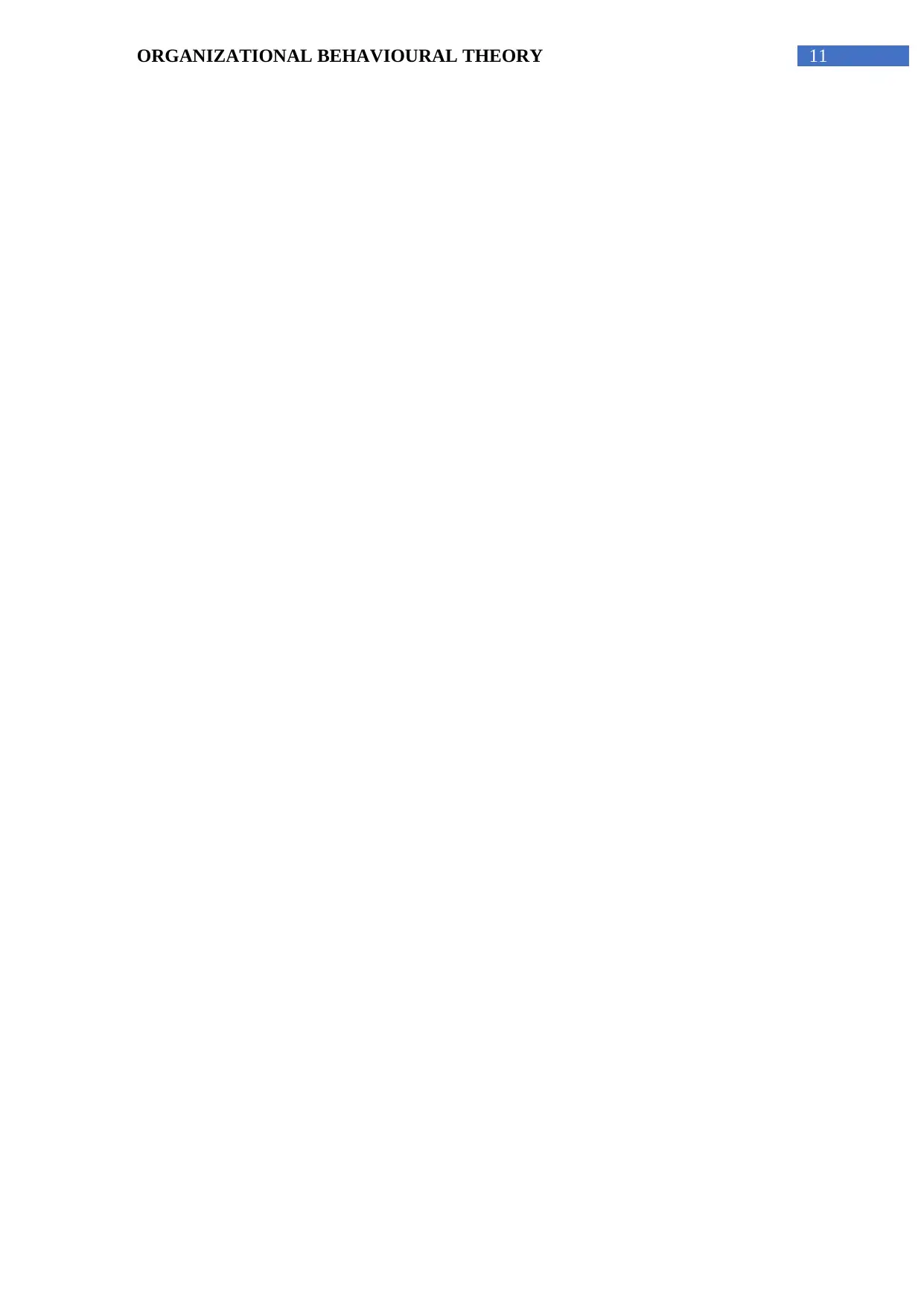
11ORGANIZATIONAL BEHAVIOURAL THEORY
⊘ This is a preview!⊘
Do you want full access?
Subscribe today to unlock all pages.

Trusted by 1+ million students worldwide
1 out of 12
Related Documents
Your All-in-One AI-Powered Toolkit for Academic Success.
+13062052269
info@desklib.com
Available 24*7 on WhatsApp / Email
![[object Object]](/_next/static/media/star-bottom.7253800d.svg)
Unlock your academic potential
Copyright © 2020–2025 A2Z Services. All Rights Reserved. Developed and managed by ZUCOL.





